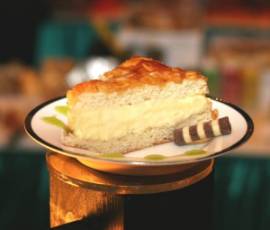 Servings: Makes 2 (8-inch) cakes, 16 servings
Servings: Makes 2 (8-inch) cakes, 16 servings
Ingredients:
Dough:
2 1/4 cups unbleached all-purpose flour
1/4 cup (1/2 stick/2 oz./56g) butter
2 tablespoons granulated sugar
1 1/2 teaspoons instant yeast
3/4 teaspoon salt
2 large eggs
1/4 cup water
Topping:
6 tablespoons (3/4 stick/3 oz./84g) butter
1/3 cup granulated sugar
3 tablespoons honey
2 tablespoons heavy cream
1 1/2 cups sliced almonds
Filling
2 teaspoons unflavored gelatin (about 2/3 of a packet, or 3 to 4 sheets)
2 tablespoons water
1 cup heavy cream, whipped to very soft peaks
1 (3-ounce) package instant vanilla pudding mix
1 1/2 cups milk
1 teaspoon vanilla extract
Instructions:
Manual/Mixer Method:
Combine all of the dough ingredients in a medium-sized mixing bowl, stirring until the mixture becomes cohesive. Transfer the dough to a lightly oiled or lightly floured work surface, and knead it for 5 to 8 minutes, until it is smooth OR knead it in an electric mixer, using the dough hook, for 4 to 7 minutes at medium speed. Place the dough in a lightly oiled bowl, turn to grease all sides, cover the bowl with a proof cover or plastic wrap, and let it rise for 60 minutes, until it is puffy.
Bread Machine Method:
Place all of the dough ingredients into the pan of your bread machine in the order recommended by the manufacturer (usually, liquids first, yeast last). Program the machine for dough or manual, and press Start. After about 10 minutes of kneading, check the dough’s consistency; it should be fairly smooth, slightly sticky, not dry and "gnarly." Adjust its consistency with additional flour or water, if necessary, and allow the machine to complete its cycle.
Shaping:
Transfer the dough to a lightly oiled work surface, fold it over to expel any excess gas, then divide it in half. Roll each piece into a ball, then pat and stretch each ball into an 8-inch circle. Place the circles into two lightly greased 8-inch cake pans; don’t worry if the dough shrinks away from the edges of the pans. Allow it to rise/rest for 30 minutes-the gluten will relax, making the dough easier to work with-then gently stretch and pat it to reach the edge. Make the topping while the dough is rising.
Topping:
Melt the butter in a small saucepan set over medium heat. Add the sugar, honey and cream. Bring the mixture to a boil, and boil it for 3 to 5 minutes, until it’s taken on a very light gold color. Stir in the sliced almonds, let cool slightly, then spread over the dough in the pans.
Baking:
Bake the Bienenstich in a preheated 350°F/180°C oven for 25 to 28 minutes, until the edges are golden brown and the topping is bubbling. Remove it from the oven, and cool in the pan for 30 minutes, to allow the topping to firm up. Run a knife around the edges of the pans to loosen any stuck-on dough, and flip each cake over onto a plate, then flip back onto a rack so the almond topping is up. Cool completely before filling.
Assembly:
Carefully split each of the cakes in half horizontally, so that you have four thin, round cakes. This is best done using a serrated knife; cut slowly and check as you go to make sure you’re staying on a straight line. Set the cakes aside.
Soften the gelatin in the 2 tablespoons water, then heat the mixture (in a microwave set on low, or over low heat in a saucepan) until the gelatin has melted and the mixture is clear. Let it cool slightly.
Fold a bit of the whipped cream into the gelatin, then fold that back into the remaining whipped cream.
Mix the instant pudding with the milk and vanilla, stirring for 2 minutes as the box directs. Immediately fold the whipped cream/gelatin mixture into the pudding (the pudding will begin to set up, so work quickly). Use this faux pastry cream to fill the cakes. Serve immediately, or refrigerate until you’re ready to serve.
Makes 2 (8-inch) cakes,16 servings.
Note: We really like this method of making pastry cream; both the ease of preparation, and the delicious final product. The whipped cream makes the filling very rich, while the gelatin stabilizes it, so it’ll stay firm (and not "weep") in your pastry for days, if necessary. When we’re in a hurry, and know we’re making a pastry that doesn’t have to keep for a long time, we simply prepare instant vanilla pudding mix using heavy cream instead of milk, spiking it with an extra shot (a teaspoon or two) of vanilla extract. Either of these two methods produces a filling that’s wonderful for cream puffs, éclairs, napoleons (if you ever make those at home), cakes, or other filled confections.
Source: Recipe adapted from King Arthur Flour
Date: May 7, 2006